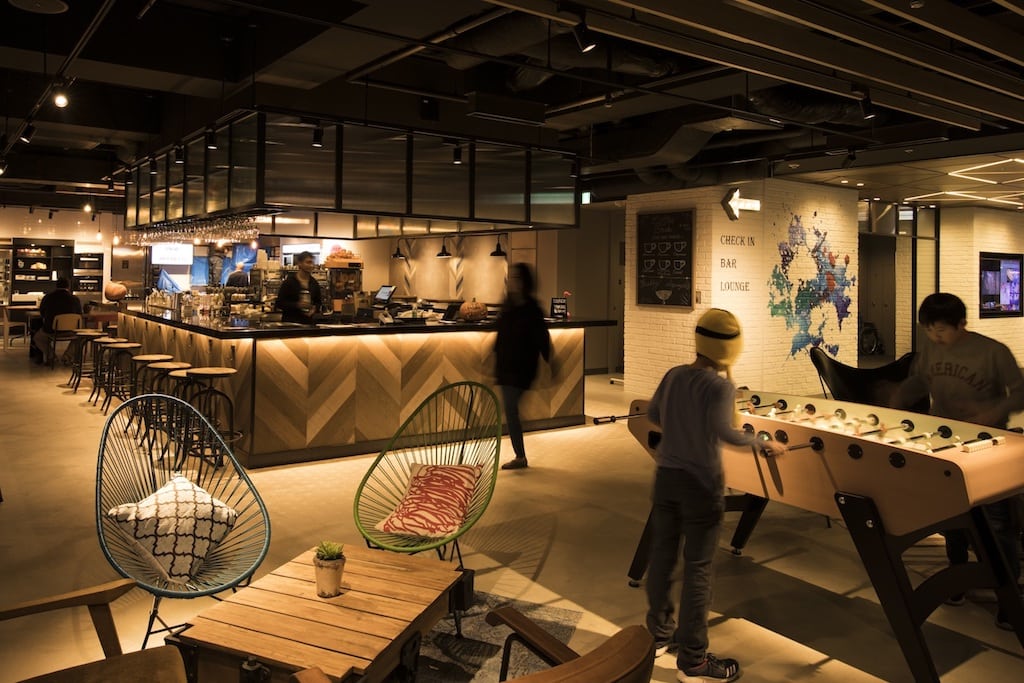Skift Take
Marriott is already dabbling in tours and activities, homesharing, and cruising and soon, potentially, all-inclusive resorts. So, what's next? Aviation?

Anthony Capuano, Marriott International’s executive vice president and global chief development officer / Source: Marriott International
Since Marriott International acquired Starwood Hotels & Resorts for a $13.3 billion in 2016, the company — now considered to be the world’s largest hotel company — has been on a roll.
Just recently, Marriott announced an all-time record pipeline of nearly 465,000 new hotel rooms getting ready to open worldwide. In the first quarter of 2018 alone, the company signed contracts for nearly 20,000 rooms.
Leading Marriott’s global development team and its push for expansion and growth through more hotels is global chief development officer and executive vice president Anthony Capuano, a 23-year veteran with the company who was appointed global chief development officer in 2009.
Skift recently spoke with Capuano in our New York City office to discuss a variety of hospitality topics, from Marriott’s growing partnership with Simon Property Group, one of North America’s largest mall developers, the company’s homesharing pilot, and its eventual plans for new brands and products.
What follows are excerpts from our conversation with Capuano.
On Marriott’s Homesharing Endeavors
As Marriott and its peers, such as Hyatt and AccorHotels, attempt to grow their global footprints not just with traditional hotels but also with homesharing, Capuano said that he and his team are trying to ascertain how similar — or dissimilar —development can be in this particular part of the accommodations market.
He said, “We have some intuition that [homesharing] can be complimentary to our core business, that the users of homesharing have an appetite and interest in something that’s not necessarily readily available in many of the home sharing platforms today,” referring to assurances of quality, cleanliness, and safety, and in Marriott’s case, the ability to use loyalty points to earn and redeem nights for homeshares.
Marriott’s six-month pilot with short-term rental property management company Hostmaker, he said, represents the company’s attempt to “test out the theses that there is a segment at the top of the homesharing market” where traditional hotel companies like Marriott can find opportunity.
Capuano doesn’t see Marriott ever playing into more “alternative” forms of private accommodations, such as “shared extra bedrooms, or couches, or yurts, or any other alternative accommodation,” but he added,”we do think in the multiple bedroom, highest end of that market, there might be a complimentary opportunity for us. We’ll test it here for a few months and see what we learn.”
As for how well the pilot is progressing, he said, “The early reactions have been terrific. What I hear from the team anecdotally, is that the reservation volume we’re seeing is above what we had anticipated, but within terms of absolute room nights and average rate.”
When asked if Marriott would continue pursing more homesharing products under the umbrella of its existing Tribute Portfolio soft brand collection versus launching a new homesharing brand, Capuano said it’s like Marriott would stick with the former. He likened that form of branding to a sort of “Good Housekeeping seal.”
“I think our early instinct is that aligning it with one of our established brand makes sense, but there’s more to come as we get more and more consumer feedback,” he noted.
Another aspect of homesharing that the company will also watch closely is to look for “economic synergies” between the company’s existing hotels and newer homesharing units.
Capuano also said that the company’s extensive experience in branded residences will also help Marriott navigate the homesharing space.
“We’re the biggest global branded residential company,” he said. “We’ve got, if memory serves, about 80 branded residential projects around the world, another 40 in the active signed pipeline. So those are often mixed-use projects, where you have maybe a Ritz-Carlton hotel somewhere lower in the tower, and then Ritz-branded residences on top. … I think our grounding in how those towers function, gives us a lot of opportunity to look at parallel synergies in home sharing, if that’s a business that decide to grow more aggressively.”
As will Marriott’s serviced apartment business, where Capuano believes it falls upon Marriott and the overall serviced apartment sector to rethink their positioning with consumers.
“I think people have historically looked at service departments as, ‘I’m on a six-month assignment, or a special project, or my company has said, ‘We need you to go here for a temporary two-year assignment,’ versus looking at a Marriott Executive Apartment and saying, ‘I’m taking my family on vacation for a week, and I want multiple bedrooms, and I want a kitchen facility, and a laundry, and a living space,'” Capuano said. “It’s really incumbent on us, and this is true across the whole brand portfolio.”
As for the results Marriott will review at the end of this initial pilot, he said the company will ask the following: “Was it economically beneficial to the individual home owners? Was it economically beneficial to Hostmaker, who’s our partner in this test? And did it make economic sense to Marriott? We’ll want to see was it in fact complimentary to our hotel owners in that market. Did the consumers, the guests, that tried it out — was it what they were looking for? Was it a compelling proposition?”
On Why It’s Always Made Sense for Malls to Have Hotels
Earlier this month, Marriott announced it would open at least five new hotels inside Simon Malls throughout North America as part of an expanded partnership — and despite the fact that “the death of the American mall” has been a recurring new story for at least the past four to five years.
When Skift asked Capuano why hotels and malls were a good fit, he said having these types of mixed-use developments just makes good business sense.
“I think from a hotel perspective — I said [this] to someone the other day — North America’s almost behind the rest of the world. In many other areas of the world, retail developers have always said, mixed-use is the way to go, and the hospitality and retail uses are quite complimentary,” Capuano said.
Not only that, but it’s just convenient for hotel guests to be so close to all that a shopping center has to offer.
“If you think about it, when we all travel, inevitably, you’d like to find interesting food and beverage options immediately adjacent to the hotel,” Capuano said. “You might have spare couple hours and you want to go shopping. I think it’s just a really complimentary use for travelers, whether they are business travelers, groups, or certainly leisure travelers. I think it compliments each other. And from the retail side, it gets more feet walking through the retail center, so I think it’s a win, win for both uses.”
He’s also skeptical of news stories that say the growth of e-commerce and online retail giants like Amazon are killing malls. And if anything, by transforming malls more into full entertainment centers, the mall is more relevant than ever.
“I don’t buy it,” Capuano said. “I think retail is alive and well. I think the bricks and mortar retail continue to innovate to make sure they stay as relevant as they are today. Whether that’s through tweaking their tenant mix, whether that’s through supplementing their food, and beverage, and entertainment offering. They, like every other real estate use continues to evolve and innovate. We see lots and lots of really vibrant malls.”
Marriott’s 31st Brand?
In previous conversations with Capuano, he has acknowledged all-inclusive resorts as a potential new area of expansion for the company, and while he didn’t divulge many new details on Marriott’s plans to enter that part of the market, he did add some background to how the company is thinking about doing so.
“We think it’s obviously a rapidly growing business, and to me, because I have the good fortune to get a bit of global view, it’s not just a platform that makes sense in Caribbean,” Capuano said of all-inclusive resorts.
He said he’s seen more all-inclusive resorts emerge in Easter Europe and Southeast Asia, and that Marriott’s partnership with Alibaba has shown “that model of this one price, truly all-inclusive vacation seems to resonate increasingly with outbound Chinese travelers.”
Keeping Hotel Owners Happy
As Marriott continues its growth as an asset-light company in an increasingly franchise-driven model, it’s also having to assuage the growing concerns that many of its owners have: Namely, that there’s a chance that the company could, potentially, max out all of its 30 brands in any one market and cannibalize its hotels’ business in the process.
Capuano said the company has a number of specific controls in place to prevent that situation from occurring.
“I think, No. 1 , we have a very robust process that the owners participate in to evaluate perspective impact on their hotels,” Capuano said. “If you’re the owner of a Courtyard and we’re proposing a Residence Inn in your market, we send you a notification. You have the ability to ask us to hit the pause button on our consideration of that project, and hire a third-party consultant to evaluate the impact. We have guidelines when we see the results of that study, where we might say, ‘We’re going to take a pass on that project because the impact might be too significant.'”
And even thought it might seem like Marriott is poised for global domination of the accommodations market, he added, “On a global basis, we have less than 10 percent market share today. So, we think we’ve got a lot of runway in terms of our ability to grow our global brand.”
And that’s why Marriott is so eager to pursue more international deals.
China and Other Key Growth Markets
Like nearly every other major hotel company on the planet, Marriott is committed to growing its business in China and for Marriott, specifically, a big key to that growth will be through its loyalty program and making sure it’s easy for Chinese outbound travelers to have access to mobile payment options just like they enjoy back home.
Elsewhere, Capuano said the company is taking a very close look at Japan and Eastern Europe, as well as Colombia.
“Japan is on fire right now, and it’s an easy explanation to say, well they have the Olympics coming, but it’s much more than that,” he said. “When you look at some of the economic trends in Japan, it’s a strong and growing market, and a market where we really have terrific traction.”
One potential development he is paying particularly close attention to in Japan is the granting of casino licenses and potential opportunities for Marriott to handle the management of a hotel that’s part of a major casino resort development.
At the end of the day, Capuano, said, Marriott’s growth strategy is pretty straightforward: “In some ways, my job is the easiest job in the company. People say, well what’s your growth strategy? We want to deploy the right brand everywhere our customers want to be.”
Have a confidential tip for Skift? Get in touch
Tags: homesharing, marriott
Photo credit: The Moxy Tokyo Kinshicho opened in Japan earlier this year. Marriott's global chief development officer, Anthony Capuano, said Japan is one market the hospitality company is eyeing for future growth and expansion. Marriott International
